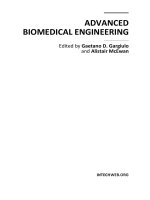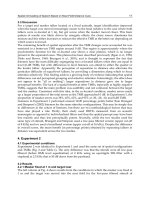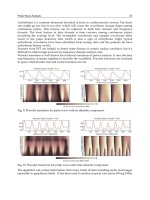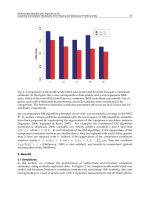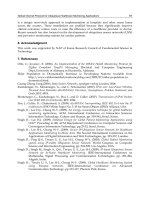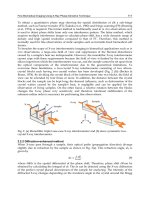Advanced Biomedical Engineering Part 15 pdf
Bạn đang xem bản rút gọn của tài liệu. Xem và tải ngay bản đầy đủ của tài liệu tại đây (1.31 MB, 10 trang )
Legislation, Standardization and
Technological Solutions for Enhancing e-Accessibility in e-Health
271
The aids provided by specific technological requirements for people with disabilities are
classified according to the logic of the operation: alternatives (to allow replacement of a
methodology or tool method, or tool “alternatives” that can be used by the subject),
enhancement (to supplement the shortage of functional resources in subjects to perform an
action or to “enhance” the low productivity of these) and substitutes (to allow the
replacement of an absent or damaged functionality in the subject by another which the
subject does have) [25].
This section will present and discuss the recommended technology requirements for each
type of disability:
• Psycho-cognitive diversity and ageing people: providing solutions to the difficulties
people have in learning and understanding abstract or complex concepts, the
establishment of relationships between concepts, carrying out tasks with complex
structures, the use of short term memory, interpretation and memorization of long
sequences of operations, the ability of understanding of language, etc. These include
many resources of the ICT environment: environment control, safety control,
telemedicine, telecommuting, distance education and training, adapted jobs, etc.
• Physical diversity: incorporating solutions to issues related to mobility and manipulation
including mobility and transportation, hygiene and personal care, household tasks,
computer access, support for autonomy, etc.
• Sensory diversity: very different solutions that target visual diversity (including mobility
aids, reading aids, writing aids) and hearing diversity (personal communication,
telephony, communication in general, etc…)
There is great awareness in companies about new developments conforming to the
standards that establish guidelines to implement the idea of design for all [26]. The general
objective is to develop technologies for building channels of communication and interaction
between people with some kind of special need and their environment. Different products
and assistive devices [27] include many technological resources that are explicitly designed,
manufactured in standard mode, or adapted from those already manufactured. These
products can help people with functional diversity to overcome or mitigate their disabilities,
providing access to greater autonomy and improved quality of life. An analysis of the most
significant specialized medical devices and products is given below grouped by type of
functional diversity [28]-[30].
4.1 Psycho-cognitive disability and ageing people
Some of the recent advances in this context of e-Health include special types of mouse with
devices that allow moving the digital cursor over the screen through foot movements, or
context keyboards (see Figure 4). These context keyboards are designed with pictograms
instead of letters on every key in order to develop the augmentative communication of the
patient through images that help to represent her/his needs [31].
Another milestone is the photo-sharing model, used by many parents with autistic children,
which allows children to construct sentences through a book containing photographs of real
objects collected through their own experiences. Grace [32] is an iPhone application based
on a system of communication through images with which it is expected to help autistic
people improve their social skills. It has more than 300 symbols and pictures stored on the
iPhone terminal reflecting current day-to-day vocabulary of society. It also allows new
pictures to be added at any time as the vocabulary grows.
Advanced Biomedical Engineering
272
Among applications for elderly people, the Cogknow project [33] aims to help minimize the
overall risk of exclusion of older people with dementia, focusing the action on several
aspects of their lives: memory, continuity of social contact, ability to perform daily activities,
and increased safety. A mobile device (Smartphone or Pocket PC) has been developed
which allows the elderly to remember their daily activities (using images), and to easily
contact their families by simply clicking on the picture of the person they want to
communicate with. Furthermore, the same device will act as a Global Positioning System
(GPS) locator so that the carer or relative can monitor the movements of the user.
The large touch screens that allow applications to be opened and managed with a simple
hand gesture are only a foretaste of what our relationship with technology will be in the
coming years. Some other highlights of the technology applied to user interface design are
shown in [34], and an example of these advances is the Gesture Cube [35], see Figure 5.
While touchpads are now handled by dragging the fingers over the screen according to
certain paths and geometries, the interface of the future will be handled by gestures alone.
As its name suggests, the Gesture Cube senses and interprets hand movements and it can
operate with various devices. The user moves the hand towards or away from the cube or
waves the hand in front of it, while a series of sensors instantly detect the hand position and
transmit the coordinates to the electronics installed in the interior. Thus, certain preset
movements can be programmed to perform certain actions such as opening a program.
Fig. 4. Context keyboards (figures extracted from their respective websites, see references)
Fig. 5. Gesture Cube (figure extracted from website, see references)
Legislation, Standardization and
Technological Solutions for Enhancing e-Accessibility in e-Health
273
4.2 Physical disability
There have been many medical advances in this field. Some highlights are glucose
analyzers/meters (with strips including a capillary action that automatically acquire the
blood and a beep to warn that the application is completed, the test result appearing on the
display and also spoken through a synthetic voice), digital talking body thermometers
(suitable for armpit, oral and rectal use with memory of the last measurement), or Head
Pointer systems (suitable for people who have good head control and are able to use the
computer keyboard with the head). The most significant advances are listed below:
• Licorn. This is a helmet with a built-in metal rod holding a small stylus or pencil. This
is for operating the computer keyboard for people with good head control.
• Ergonomic mice and push-buttons. Special ergonomic mice operated by ball, tablet or
plaque, keys, even the floor, wireless, head, joystick, push buttons, touch screen, voice,
eyes, etc. With head mice, the user's head movements are processed by the system that
moves the cursor on the computer screen. In mouse control by the iris, the system
allows the user to place the mouse pointer anywhere on the computer screen simply by
looking at that point. There are also virtual mice whose movement and click options
appear on the screen operated by a push-button.
(a) Licorn
(b) Ergonomic mice
(c) Push-buttons
Fig. 6. Hardware devices for physical disability (figures extracted from their respective
websites, see references)
Advanced Biomedical Engineering
274
4.3 Sensory (visual, hearing and speech) disability
Typhlotechnology is the adaptation and accessibility of ICTs for their use and implementation
by people with blindness and visual impairment. A very detailed review of technological
advances in typhlotechnology developed for people with visual functional diversity was given
in [36]. Some other highlights of the technology applied to visual impairment were reviewed
for this work and are collected in [37]-[46]. The most significant are listed below:
• USB Braille keyboard [47], for people with visual disability. As shown in Figure 7(a),
this allows Braille letters to be entered, either completely replacing the conventional
keyboard or working simultaneously with it. Braille input keys are arranged in a central
ergonomic manner in two groups of 4 keys. The extra keys around the Braille keys
correspond to a standard MF2 keyboard regard in terms of their function and form. The
keyboard allows the combination of cells of six and eight points to generate characters
following the American National Standards Institute (ANSI) Braille table.
• CdBraille [48], see Figure 7(b), is a relief printing system for Compact Disc (CD) and
Digital Video Disc (DVD). This technology allows printing the surface of CDs and
DVDs in Braille language.
• Nokia Braille reader [49], see Figure 7(c), is an application for touch screen phones that
allows people with blindness or reduced vision to be able to write, read and send text
messages. This system operates through software that displays on the screen a series of
black and white circles on which the fingers can rest. Light vibrations can be felt that
allow users to decipher the message. This is a Braille reader that translates text
messages and reproduces them on touch screen phones with haptic feedback.
• Loadstone GPS [50] is a program to help blind people; it combines GPS and voice
recognition systems, developed by two blind programmers. It is free and open source
with the aim of “helping the blind to get from point A to point B”. Another option also
based on GPS is Mobile Geo [51], which is still in development.
(a) USB Braille Keyboard (b) CdBraille (c) Nokia Braille
Fig. 7. Advances for physical disability (figures extracted from their respective websites, see
references)
Some other highlights of the technology applicable in cases of hearing disability have been
reviewed for this work and are collected in [52]-[53]. The most significant are listed below:
• A recent example, made in Spain, is the Barakaldo phone 010, which serves people with
hearing and speech disabilities [54]. These groups can communicate with their local
councils or authorities through a new system. Through their mobile phones and
Personal Digital Assistants (PDAs), they can chat with the operators of the service.
• The Telesor system [55], allows public and private organizations to provide telephone
services to people with hearing or speech disabilities, in a manner equivalent to that
offered to a hearing person through voice phone. This ensures that all inhabitants with
hearing or speech disabilities can communicate through their mobile devices (cell
Legislation, Standardization and
Technological Solutions for Enhancing e-Accessibility in e-Health
275
phones and PDAs) with public and private telephone services. This communication is
always made in real time via text and character to character communication mode. It is
necessary to install a free widget on the mobile phone that will provide the
functionality and user interface required.
• The cochlear implant is a device designed to reproduce the function of the cochlea
through implanted electrodes. It uses a few external components (microphone,
processor and transmitter) whose function is to collect, process and transmit sound to
the electrodes. Cochlear implants, therefore, are designed to help people with profound
deafness who are unable to benefit from hearing aids.
Finally, specific medical devices adapted for sensory disabilities and their associated
hardware are described below (see Figure 8):
• Glucose analyzer (see Figure 8(a)). The strips are equipped with a capillary action that
automatically places the blood in the alveoli of reaction. Very little blood is required. A
beep alerts the user that the application of the blood has been completed. After 30 seconds
the test result appears on the display in large print and is spoken by a synthetic voice.
• Talking thermometer (see Figure 8(b)). The talking digital body thermometer has an
audible alert and memorises the last measurement.
• Talking blood pressure monitor (see Figure 8(c)). This uses a digital Liquid Crystal
Display (LCD) and an oscillometric measurement method. The measurement process is
accompanied by the addition of brief pre-recorded messages. There are also sound
signals to indicate the end of the measurement. There are other models with facilities
for language selection or disabling playback voice messages. The monitor announces
the results shown on screen, whether they are valid as if there is an error. The date and
time of measurements stored in the memory are recorded.
• Braille blood pressure monitor (see Figure 8(d)). Shenzhen ND Industrial Design has
developed this blood pressure monitor made of a soft, flexible material which can be
placed around the wrist. The results are shown in Braille by means of dots
corresponding to the data being generated on the surface. Designed for people who
have impaired vision, blindness, difficulty in hearing or who are completely deaf [56].
• Medicine dispenser (see Figure 8(e)). Adapted to the thread on a medicine bottle, this
dispenses 5 ml doses of the liquid. The fluid passes through a small chamber with 5 ml
capacity to facilitate accurate measurement.
• Pill organizer (see Figure 8(f)). On the upper side are the initials of the days of the week
in Braille. Each day has four boxes with the Braille letters "a", "b ", "c" or "d",
corresponding to 4 different times of day (morning, noon, afternoon and evening) when
the medication is taken.
• Braille keyboard (see Figure 8(g)). Tecnalia has developed for ONCE a small wireless
Bluetooth technology Braille keyboard. This application may be used by people with visual
disabilities in both desktops and laptops as well as on PDAs and mobile phones [57].
• Screen magnifier (see Figure 8(i)). This type of adaptation is probably the first that
appeared on the market and involves enlarging the characters and other content on the
screen by up to six or seven times their normal size. This application requires screen
magnifier software and manual handling equipment.
• Image magnifier. This equipment has an expansion chamber which projects the image
of the object captured on a screen. Depending on their visual ability, the image
magnifier allows users to adjust contrast, colour, sharpness, brightness and focus,
Advanced Biomedical Engineering
276
according to their own needs. For older people, the use of the magnifier means
recovering their eyesight for many tasks that allow them to be independent.
• Screen magnification software. This software extends by up to twenty-five times the
original size of the objects visible on the screen in all Windows applications. The screen
magnifier ZoomText is character magnification software that allows the user to see text
and drawings through a virtual magnifying glass at the size required.
• Voice reader (see Figure 8(h)). The Korean Sungwoo Park has developed an audible
reader for the blind and called it Voice Stick. The device is a handheld scanner that
combines Optical Character Recognition (OCR) and text-to-speech technology. It can
read literally any text and convert it into audio which the user receives through
headphones [58].
• Screen readers. These are a form of AT potentially useful for people who are blind or
have vision problems, or learning difficulties. They are often combined with other AT
applications such as screen magnifiers. The choice of screen reader is determined by
several factors, including the platform or the cost. There are so many that we
summarize the most important in a descriptive table (see Table 2).
Name Author S.O. Notes
95Reader SSCT Windows Ja
p
anese.
Blindows Audiodata Windows
Supports
M
icrosof
t
Active Accessibilit
y
and
Java Access Brid
g
e.
HT Reader HT Visual Windows Include su
pp
ort for MSAA and PDF.
iZoom Issist Windows
Screen Ma
g
nifier. Includes support for Mozilla
Firefox.
Linux Screen
Reader
GNOME GNOME Supports AT-SPI.
LookOUT
Choice
Technolo
gy
Windows
Also available inte
g
rated with screen
ma
g
nifier.
Magic
Freedom
Scientific
Windows Magnifier that can be used with JAWS.
Mobile Speak Code Factory
S
y
mbian,
Windows
Mobile
Supervisor by cells.
PC-Talker
Kochi S
y
stem
Develo
p
ment
Windows Japanese Reader. Supports MSAA and Flash.
PCVoz EzHermatic Windows Su
pp
orts MSAA.
Simply Talker
EcoNet
International
Windows Trial version available.
Virgo
BAUM Retec
AG
Windows Supports MSAA and Java Access Bridge.
Virtual Visio
n
MicroPower Windows Su
pp
orts MSAA.
VoiceOver Apple Mac OS X
Distributed with Mac OS X, uses the Apple
Accessibilit
y
API.
Window-E
y
es GW Micro Windows Su
pp
orts MSAA.
ZoomText Ai Squared Windows
Ma
g
nifier that includes support for voice
s
y
nthesizer.
Table 2. Medical devices for physical disability
Legislation, Standardization and
Technological Solutions for Enhancing e-Accessibility in e-Health
277
(a)
Glucose Anal
y
zer (b) Talkin
g
Thermometer (c) Talkin
g
Blood Pressure
(d)
Braille Blood Pressure (e) Medicine dispenser (f) Pill organizer
(g) Braille Keyboard (h) Voice Reader
Fig. 8. Medical devices for physical disability (figures extracted from their respective
websites, see references)
5. Acknowledgements
This work was partially supported by projects TIN2008-00933/TSI of the Innovation and
Science Ministry (MICINN) and European Funds for Regional Development (EFRD), TSI-
020100-2010-277 and TSI-020302-2009-7/Plan Avanza I+D of Ministry of Industry, Tourism
and Trade.
6. References
Romañach Cabreo J., Palacios A. El modelo de la diversidad. La Bioética y los Derechos
Humanos como herramientas para alcanzar la plena dignidad en la diversidad
funcional. Ediciones Diversitas – AIES, 84-964-7440-2, 2008.
World Health Organization (WHO). Last visit: 03/2011.
International Classification of Functioning, Disability and Health (ICF).
classifications/icf/en/. Last visit: 03/2011.
Advanced Biomedical Engineering
278
Design for all. . Last visit: 03/2011.
International Conference on Computers Helping People with Special Needs (ICCHP).
“e-Accessibility: Equality = e-Quality”. ICCHP. www.icchp.org/2006/. Last visit: 03/2011.
Windows® API Code Pack for Microsoft® .NET Framework
Last visit: 03/2011.
Design for all. www.designforall.org/en/downloads/dossier-DfA-Fd-ang.pdf. Last visit:
03/2011.
Villarino, P. & Cayo, L. Discapacidad: Nuevas realidades, nuevos términos. CERMI, 2004.
The Universal Declaration of Human Rights.
Last visit: 03/2011.
Treaty of Amsterdam.
/>_ treaty/index_en.htm. Last visit: 03/2011.
Charter of Fundamental Rights of the EU. 2000.
text_es.pdf. Last visit: 03/2011.
Commission of the European Communities. “eEurope 2002 Action Plan: accessibility of
public websites and their content (2002/C 86/02)”.
Last visit: 03/2011.
—. “eEurope 2005 Action Plan: An Information Society for all”.
Last visit: 03/2011.
—. “i2010: A European Information Society for growth and employment”.
Last visit: 03/2011.
ISO9241. Ergonomics of human-system interaction. www.iso.org/iso/catalogue_detail.htm?
csnumber=37031. Last visit: 03/2011.
—. Part 151: Guidance on World Wide Web user interfaces.
/>ber=37031. Last visit: 03/2011.
—. Part 171: Guidance on software accessibility
/>ber=39080. Last visit: 03/2011.
—. Part 110: Dialogue principles
/>ber=38009. Last visit: 03/2011.
—. Part 11: Guidance on usability
/>ber=16883. Last visit: 03/2011.
—. Part 17: Form filling dialogues
/>ber=16889. Last visit: 03/2011.
ISO 14915 Software ergonomics for multimedia user interfaces
/>ber=25578. Last visit: 03/2011.
ISO 13407 - Human-centred design processes for interactive systems
Last visit:
03/2011.
Legislation, Standardization and
Technological Solutions for Enhancing e-Accessibility in e-Health
279
ISO 9241. Part 20: Accessibility guidelines for information/communication technology (ICT)
equipment and services.
/>ber=40727. Last visit: 03/2011.
Soto Pérez F.J., Hurtado Montesinos M.D. Tecnologías de ayuda y atención a la diversidad:
oportunidades y retos.
INREDIS. Last visit: 03/2011.
Roca Dorda J., Roca González J., Del Campo Adrián M.E. De las ayudas técnicas a la
tecnología asistiva.
Enderle J., Blanchard S., Bronzino J. Introduction to biomedical engineering. Singapore
Academic Press, 2000. 0-12-238660-4.
Marazzi, A. “Presentan una tecnología que leerá órdenes enviadas por el cerebro de
personas con discapacidades” 6 de Abril de 2010. . Last
visit: 03/2011.
Marquez, X. “Concepto de mouse para usar con tu pie” 4 de Abril de 2010.
. Last visit: 03/2011.
Tecnalia. Corporación tecnológica. o/. Last visit: 03/2011.
Widgetbox. Last visit: 03/2011.
Ferrer-Roca O., Vilarchao-Cavia J., Troyano-Luque J.M., Clavijo M. “Virtual Sonography
Through the Internet: Volume Compression Issues”. (J Med Internet Res
2001;3(2):e21) www.jmir.org/2001/2/e21/. Last visit: 03/2011.
Emedmobile. Last visit: 03/2011.
BL Healthcare. TCx Interactive System.
Last
visit: 03/2011.
Arregui Noguer B., Grau Sabaté X. , Pérez Bueno L. Tecnología y discapacidad visual :
necesidades tecnológicas y aplicaciones en la vida diaria de las personas con
ceguera y discapacidad visual. Madrid : Organización Nacional de Ciegos
Españoles, Consejo General 2004, 2004. 84-484-0125-5.
Redaccion. San Sebastián, escaparate de lo último en tecnología social. Diario Vasco. 03 de
Diciembre de 2009. />escaparate-ultimo-tecnologia/143753. Last visit: 03/2011.
Sánchez J., Aravena G., Flores H. AUDIOMEMORICE: Desarrollo de la memoria de niños
con discapacidad Visual a través de audio. Santigo-Chile : Sánchez, Jaime, 2003.
Higueras, E. Desarrollan un sistema de visualización braille a pantalla completa. s.l. :
Tendencias Informáticas. Facultad de Informática de la UPM, 2010.
/>pantalla-comp leta_a4268.html. Last visit: 03/2011.
Stack Overflow. How can you program if you’re blind? Stack Overflow. 2010.
/>blind. Last visit: 03/2011.
Shipman M., Yang P. Electroactive Polymer Design Opens Door To ‘Full Screen’ Displays
For The Blind. North Carolina State University News. 29 de Marzo de 2010.
releases/wmsdispignabraille/. Last visit: 03/2011.
Advanced Biomedical Engineering
280
Ghosh T., Chakraborti P. , Di Spigna N., Winick D. , Yang P., Franzon P. The Integration of
novel EAP-based Braille cells for use in a refreshable tactile display. San Diego: 12th
International Conference on Electroactive Polymer Actuators And Devices, 2010.
Diseño para Todos. Grafica para ciegos. Junio de 2010.
Last
visit: 03/2011.
Pardo, L. Aerozoom mejora la lupa de Windows 7. s.l. : NeoTeo, 2010. http://www.
neoteo.com/aero zoom-mejora-la-lupa-de-windows-7.neo. Last visit: 03/2011.
Toshiba. Internet Journal of emerging Medical Technologies. Coming Soon: Touchscreen
Phones for The Blind. 21 de Mayo de 2010.
touchscreen_phones_for_the_ blind.html. Last visit: 03/2011.
Toto, S. Japanese researchers develop mini brain wave measuring device. NODE. 6 de Abril
de 2010. />mini-brain-wave-measuring-device/. Last visit: 03/2011.
Antarq Tecnosoluciones. Antarq Tecnosoluciones. La alternativa a la discapacidad. Junio de
2010. Last visit: 03/2011.
Web Cdbraille. . Last visit: 03/2011.
Finnish Federation of the Visually Impaired. . fi/yleista/english.htm. Last
visit: 03/2011.
Portaltic/EP. Una mujer crea una aplicación del iPhone para sus dos hijos autistas.
Loadstone - GPS. Last visit: 03/2011.
Proyecto TELPES. Soluciones de Teleasistencia para Personas Sordas. Ciudadanía Digital
del Plan Avanza. 2008-2010.
Sign SmithTM products featuring SigningAvatar® characters. Vcom3D, Inc.
/signsmith.php. Last visit: 03/2011.
El teléfono 010 de Barakaldo. . Last visit: 03/2011.
Telesor. Last visit: 03/2011.
Shenzhen ND Industrial Design Co. Last visit:
03/2011.
Tecnalia - Corporación tecnológica. o. Last visit: 03/2011.
Sungwoo Park
/>ort_by=1&. Last visit: 03/2011.


